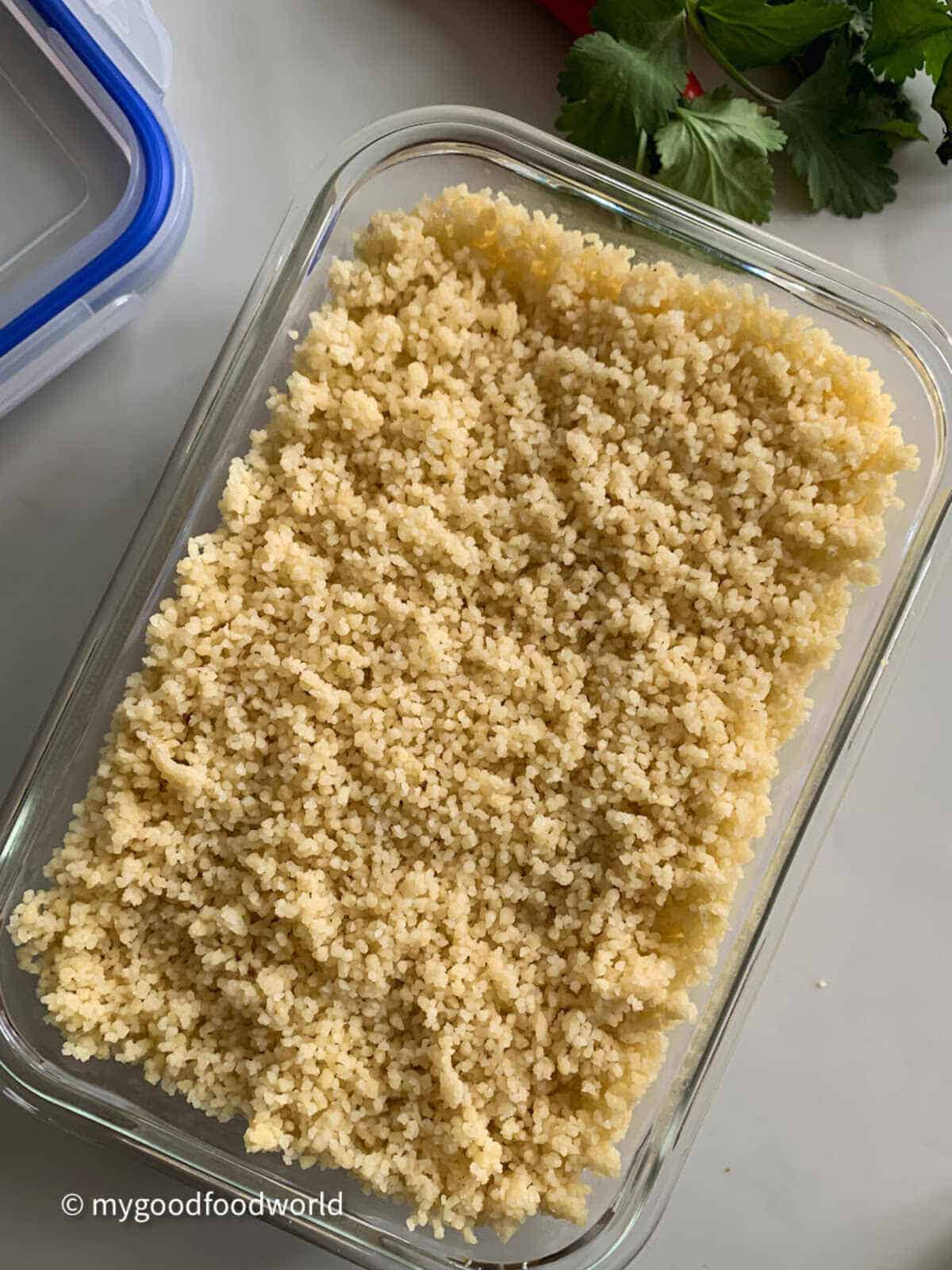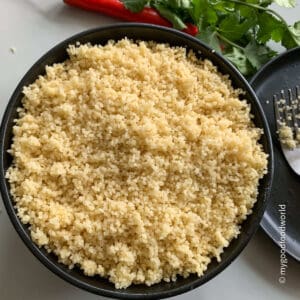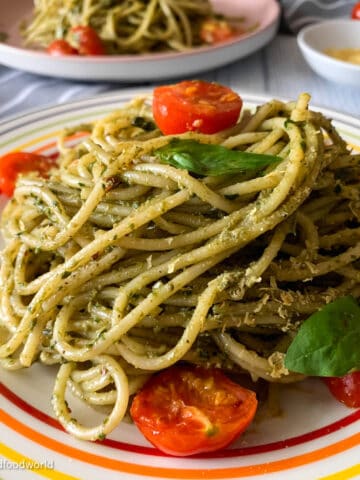Since becoming intolerant to gluten, there are a lot of questions in my mind about the ingredients that I use in my cooking. Is buckwheat gluten-free was one of them. "Is couscous gluten-free" is another question on my mind. Read on to know more of what I have come to know plus an easy and basic recipe for cooking couscous.

Couscous is a fairly new ingredient in my cooking repertoire. Growing up in India, I was not familiar with it and had never had it till I started living in the UK.
It is now a regular part of my pantry and I enjoy cooking with it as it is versatile. What I love about couscous the most is, just like rice, it is a blank canvas for flavors!
Ever since I developed gluten intolerance, I do not eat couscous much, but I still make it for my girls.
Well, since I have kind of answered the question "is couscous gluten-free?" here, the rest of the article will be rather dull, isn't it?😆 - absolutely not!
Read on to know more about couscous, its types (there are quite a few!), what can be a near-perfect substitute for couscous, and a recipe for preparing couscous.
Jump to:
What is couscous?
Couscous is made from semolina - coarsely ground durum wheat - and shaped to form small spheres. It is typically golden or light brown in color.

Since pasta is also made from durum wheat, one may say that couscous is tiny, sphere-shaped pasta, although pasta is made from dough and couscous is not.
I have decided to describe it as a grain that is similar to pasta.😎
How would you describe couscous? Do let me know in the comment below. I would love to learn from you - Padma
Is couscous gluten-free?
No, couscous is not gluten-free.
Gluten is a type of protein found in certain types of grains.
While wheat is the primary source of gluten, a number of other grains such as rye and barley contain gluten as well.
Gluten causes problems for people who have gluten intolerance or celiac disease.
Semolina is a wheat product and so contains gluten. And since couscous is made with semolina, it is not gluten-free.
Many people get confused because some varieties of couscous look like rice or other grains such as buckwheat and sorghum.
Different types of couscous
Couscous is a staple of the Maghreb region, commonly known as North Africa.
Just like rice, there are many varieties of couscous and they come in all sizes - from the tiniest, bead-like grain to the big, pea-sized spheres.
Moroccan couscous: These are tiny, irregularly shaped, grain-like couscous that resembles polenta in their texture.
Also referred to, because of the yellow color, as golden couscous, this type of couscous is most commonly available and used in dishes around the world.

Instant couscous: As I have explained in the Moroccan-inspired vegan cous cous salad post, what we get in grocery stores is typically a pre-cooked and dried version of Moroccan couscous.
This type of couscous is perfect for quick cooking as it needs just some hot water to rehydrate.
Check the section below where I explain how to prepare instant couscous in just 10 minutes.
Pearl couscous: These are pretty, round, and uniform couscous that look like pearls!
Also known as Israeli couscous, Maftoul, or Ptitim, this pellet-like couscous takes longer to cook than Moroccan couscous and is a bit chewy.

Pearl couscous, generally, is light brown in color. Also known as gourmet couscous and giant couscous, you can also find tri-color pearl couscous which looks so pretty in a salad!
Lebanese couscous: Also known as Moghrabieh, Lebanese couscous is the largest of all couscous.

This pea-sized, spherical couscous takes the longest to cook and reminds me of sabudana (tapioca pearls) in their appearance.
Cook Lebanese couscous as you would any pasta - with lots of water.
What is a good gluten-free substitute for couscous
Since couscous is not gluten-free, it is not suitable if you are intolerant to gluten, have gluten sensitivity, or have celiac disease.
There are quite a few gluten-free couscous products available in supermarkets these days.
Though gluten-free, many of them are made with a mixture of corn or cassava starch and egg whites.
So do check the ingredients list carefully before choosing the gluten-free option.
Having said that, these are some gluten-free alternatives to couscous that you might want to try:
White or brown rice: Rice is not the perfect substitute for couscous, since the grains are larger. Look for short-grain rice as it looks similar and is as versatile.
Tip: Pound or coarsely grind regular rice until it has a similar, uneven texture as Moroccan couscous. Use this as a gluten-free alternative to couscous.
Millets: These are small, round whole grains that are totally free of gluten and versatile.
The smaller varieties such as foxtail millet and barnyard millet cook fast and have a neutral taste.
Quinoa: Plain quinoa has a similar texture, look and feel to couscous and can be a near-perfect substitute for it. Make sure to look for one that is free of gluten.
Sabudana: These are made from tapioca starch and come in various sizes - from small bead-like ones, the size of mustard seeds, to the larger ones that look like pearls (and therefore also known as tapioca pearls).
Tip: Sabudana works best when soaked overnight in water, just enough to cover them. By morning, the tapioca pearls would have soaked up all the water and become plump and ready to be used in cooking.
How to cook couscous
In this section, I will help you to prepare instant couscous - the one that is available in most grocery stores - to perfection in just 10 minutes.
This simple and basic recipe requires just two ingredients - couscous and water.
Check the recipe card for quantities.

Step 1: Place the couscous in a bowl. Add hot (freshly boiled) water to it.
The couscous will soak up all the water and "swell" (see notes below for yield). Bear this in mind while choosing the bowl size.
Step 2: Cover with a lid and set aside for 10 minutes.
Step 3: After 10 minutes, remove the lid and gently fluff it up with a fork or a spoon (see video below).

The couscous is now ready to be used.
You can make a warm or cold salad with it, a one-pot meal such as a vegetable pulao or a tagine. Or have it as a side to your main meal.
Recipe Notes
Yield: 1 cup (175 grams; 6¼ oz.) of dried couscous yields about 4 cups (405 grams; 14¼ oz.) of cooked couscous.
Oil or butter: You may, if you want, add 1 teaspoon of butter or oil to the hot water. This will give the couscous a velvety, creamy texture.
Water or stock?: If you are going to have couscous along with a meal, plain water will be good enough. However, if you are making a dish like this spicy couscous salad, then soak the couscous in the stock of your choice for that extra flavor.
Storage: Cooked couscous will stay in the fridge for 3-4 days.
Cool it completely and then store it in a fridge-safe container with a tight-fitting lid.

FAQs
Since couscous is not gluten-free, it is not suitable if you are intolerant to gluten, have gluten sensitivity, or have celiac disease.
There are a few gluten-free couscous products available in supermarkets these days. Though gluten-free, many of them are made with a mixture of corn or cassava starch and egg whites. So do check the ingredients list carefully before choosing gluten-free couscous.
These are some gluten-free alternatives to couscous:
White or brown rice: Rice is not the perfect substitute for couscous, since the grains are larger. Look for short-grain rice as it looks similar and is as versatile.
Millets: These are small, round whole grains that are totally free of gluten and versatile. The smaller varieties such as foxtail millet and barnyard millet cook fast and have a neutral taste.
Quinoa: Plain quinoa has a similar texture, look and feel to couscous and can be a near-perfect substitute for couscous. Make sure to look for one that is free of gluten.
Sabudana: These are made from tapioca starch and come in various sizes - from small bead-like ones, the size of mustard seeds to the larger ones that look like pearls (and therefore also known as tapioca pearls).
Couscous is made from semolina-ground durum wheat. Since couscous is not gluten-free, it is not suitable if you are intolerant to gluten, have gluten sensitivity, or have celiac disease.
I hope that I have answered your question - is couscous gluten-free - to your satisfaction? If you have enjoyed reading this and found it useful, please take a moment to leave a comment and a rating below. This will make me super happy and motivate me to create more good content for you! xx Padma
📖 Recipe

Cooking Couscous - Basic and simple recipe
Equipment
- 1 large bowl with lid
- 1 fork or spoon
Ingredients
- 1 cup instant couscous, (175 grams, 6 ¼ oz.)
- 1 cup hot water
Instructions
- Place the couscous in a bowl. Add the hot (freshly boiled) water to it.1 cup instant couscous, 1 cup hot water
- Cover the bowl and keep aside for 10 minutes.
- After 10 minutes of soaking in hot water, the couscous would have absorbed all the water. Now fluff it up, gently, with a fork or a spoon.
- The cous cous is now ready to use. Make a salad or any other dish of your choice or have it as a side to your main meal.
Video
Notes
Alternative quantities provided in the recipe card are for 1x only.
Allergens Disclaimer
Our content aims to be informative and educational, but it should not replace professional medical advice. Since manufacturing processes can vary and cross-contamination is possible, it's essential to verify product labels and allergen information. Make sure all ingredients align with your specific allergies. As readers, you bear the responsibility for ensuring allergen safety when buying or consuming foods.
Disclosure: The nutritional information is calculated using an online calculator and is based on available ingredients and preparation. It should not be considered a substitute for a professional nutritionists' advice. Changing the quantities and cooking technique will alter the nutritional calculations.





porno says
Thank you for sharing this information. You guided me well
Padma Kumar says
Thank you for reading, Porno.
Jess says
So helpful! Thank you for sharing
Sharon says
I love how easy it is to cook couscous. Add hot water and wait. Thank you for sharing about the different varieties. You are a good mom to make couscous for your daughters despite your intolerance, watch out for cross-contact.
Padma Kumar says
Thank you so much Sharon.
Fransic verso says
Wow, this is interesting, and first time to know where it is from. Never heard of Semolina before.
Padma Kumar says
Thank you so much!